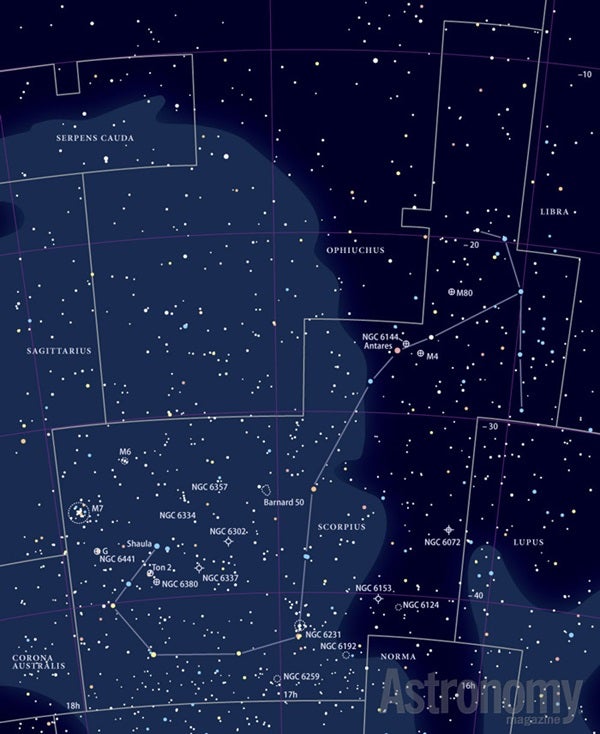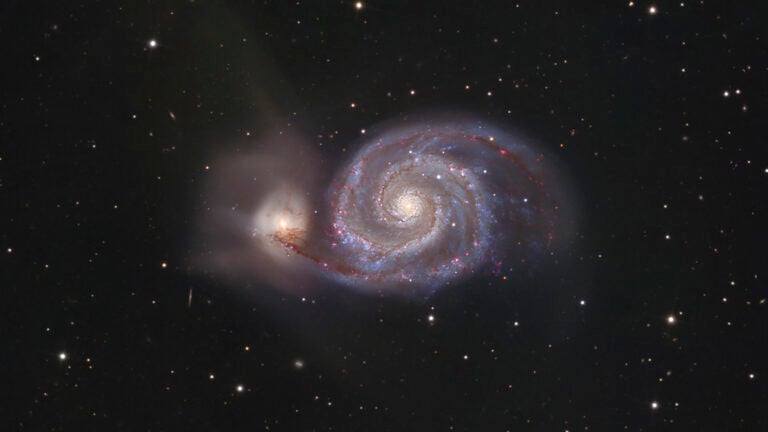Targets for July 3–10, 2014
Binoculars: The Rho Ophiuchi region
Small telescope: The Turtle Nebula (NGC 6210)
Large telescope: The Cat’s Paw Nebula (NGC 6334)
This week’s binocular object is the Rho Ophiuchi region. Astronomers named this 4°-wide section of sky for the magnitude 4.6 star Rho (ρ) Oph, but to begin searching this area, center on brilliant Antares (Alpha [α] Scorpii). Stifle your natural urge to observe globular clusters M4 and NGC 6144 — you’re here to hunt nebulae.
Start by scanning the area above (north) and to the left (east) of Antares through binoculars or through the lowest power, widest field of view your telescope will allow. For this initial hunt, look for the absence of stars caused by dark nebula Barnard 44 (B44). This dark, sharply defined lane starts at the star 22 Scorpii and runs eastward an incredible 6.5°, ending at 24 Ophiuchi.
For more detailed observations, a 4-inch or larger telescope works best. Rho Ophiuchi is a double star, with yellow components of magnitudes 5.1 and 5.7 separated by 3″. Reflection nebula IC 4604 surrounds Rho. Look for its ribbed structure. Unfortunately, a deep-sky filter won’t help with this type of object because such filters block the blue reflected light. Some observers report seeing more through a light- or medium-blue filter.
Head back to 22 Scorpii, and examine the nebula IC 4605 around it. Because IC 4605 is an emission nebula, it responds well to a deep-sky filter. American astronomer Edward Emerson Barnard, who cataloged many of the sky’s dark nebulae, described the appearance of the gas around the star: “The star 22 Scorpii strikingly resembles a human eye, the lids being formed by two strips of nebulosity, one above it and one below.”
This shell is made of gas
This week’s small-telescope target is the Turtle Nebula, also known as NGC 6210, a planetary nebula that lies in the constellation Hercules. To find it, look 4° northeast of magnitude 2.8 Kornephoros (Beta [β] Herculis).
Even through a small telescope, you can identify this planetary’s light-blue, turtle-shaped disk easily. Because it shines at magnitude 8.8 and measures a tiny 14″ across, it has a high surface brightness. That allows you to really crank up the magnification but makes spotting the magnitude 12.5 central star a bit iffy. Through the largest amateur instruments at high magnification, you’ll notice NGC 6210 is ever so slightly oval in an east-west orientation.
Here kitty, kitty
This week’s large-telescope target is the Cat’s Paw Nebula, also known as NGC 6334. It lies in Scorpius. To find this complex of emission nebulosity, look 3° west-northwest of Shaula (Lambda [λ] Scorpii). The Cat’s Paw measures 35′ by 20′, which means it covers an area 92 percent as large as the Full Moon.
Some named deep-sky objects look exactly like their namesakes. The Dumbbell Nebula (M27) and the North America Nebula (NGC 7000) come to mind. Add one more — the Cat’s Paw Nebula.
Sir John Herschel discovered NGC 6334 June 7, 1837, from the Cape of Good Hope in South Africa. He labeled it “h 3678” in his 1847 catalog. More recently, Australian astronomer Colin S. Gum gave this nebula six entries (Gum 61, 62, 63, 64a, 64b, and 64c) in his 1955 catalog, the first major survey of southern-sky HII regions. When astronomers use “HII,” they are describing a cloud of ionized hydrogen. Because neutral hydrogen is HI, the ionized form is HII.
The Cat’s Paw Nebula ranks among the Milky Way’s largest star-forming regions. It comprises five individual nebulous patches in a circular area. The brightest, which measures 6′ across and contains a 9th-magnitude star, lies on the southeastern end of the complex.
Because this object is huge, you’ll need a wide-field telescope/eyepiece combination to view it all. Another approach is to crank up the power a bit, add a nebula filter, and view each of the five areas separately.
Expand your observing at Astronomy.com
StarDome
Check out Astronomy.com’s interactive StarDome to see an accurate map of your sky. This tool will help you locate this week’s targets.
The Sky this Week
Get a daily digest of celestial events coming soon to a sky near you.
Observing Talk
After you listen to the podcast and try to find the objects, be sure to share your observing experience with us by leaving a comment at the blog or in the Reader Forums.











